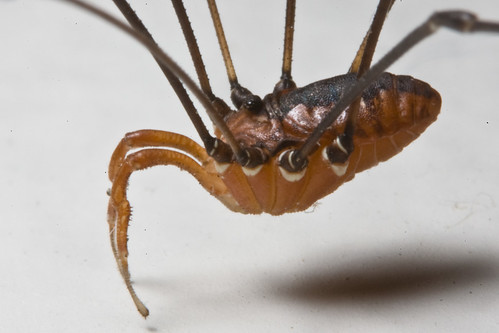Ancient Opiliones
Not so long ago Chris at Catalogue of Organisms decided to devote the next few years of his life to sorting out the nomenclature of the long-legged harvestman, a task that he admitted was prone to make him
Run screaming in horror from the entire concept of Asian Gagrellinae and end up crouched into the fetal position and whimpering in the darkest recesses of the wet collection.You gotta respect a man who can take on his deepest fears like that (either that or prepare to offer him round-the-clock in-house meds, nursing and security).
I can't offer much about the harvestmen, except the most basic tidbits. While harvestmen are arachnids like spiders, they are not spiders, but belong to a sister group (order Opiliones) of the spiders (order Arenea). The most immediate visible difference between harvestmen and true spiders is the appearance of the body: spiders have a clearly defined two part body form consisting of a cephalothorax and an abdomen separated by a "waist", while harvestmen have a body in which the two sections appear fused into one oval shape.
Contrary to popular myth, Harvestmen pose no danger to humans, not because they can't pierce human skin (which all but the largest species can't, but that's beside the point), but because they have no piercing "fangs" and no venom glands. In the image you can clearly see the chelicerae, which have no piercing structures, unlike the true spiders.
Last tidbit...the Opiliones are an ancient group and have left some interesting fossils, including a 400 million year old fossilized penis. The
The current and previous record holders? The Ostracod.
Update: I was wrong about the current record holder for the oldest known male genitals... not 3 months after the 412 Myo fossil harvestman was documented, a 425Myo Ostracod was documented with well preserved male member.





















And at the link... "the world’s oldest genitals — belonging to 400 million-year-old insects". Grrr.
ReplyDeleteAnd yep, I've got Eophalangium sheari Dunlop et al., 2004 (the fossils in question) under Eupnoi incertae sedis. The really remarkable thing about these fossils, though, is that despite being 400 million years old they don't look any different from modern harvestmen. Harvestmen don't exactly embrace novelty very much.
hey, once you've got a successful niche, why change?
ReplyDeleteThis is interesting. I, like most people I guess, would have just assumed they were spiders. The kids are now fascinated with these.
Re: Insects.. Yeah, the quote was from CNN. At least New Scientist had it right. (Man I would hope so!)
ReplyDeleteKate they are interesting critters including those eyes. Their bodies remind me of a pod racer for some reason.
I guess they're just a Star Wars kind of animal - the way they walk has always put me more in mind of the two-legged walkers in Return of the Jedi - same sort of slow but jerky bob.
ReplyDeleteAnd I've got a horrible feeling that I should be able to tell you exactly which species of Leiobunum you've got in your photograph there, but unfortunately the name escapes me.
I guess they're just a Star Wars kind of animal - the way they walk has always put me more in mind of the two-legged walkers in Return of the Jedi - same sort of slow but jerky bob.
ReplyDeleteAnd I've got a horrible feeling that I should be able to tell you exactly which species of Leiobunum you've got in your photograph there, but unfortunately the name escapes me.
Is that black bead on top an eye? Do they have many eyes like spiders?
ReplyDeleteThey are crazy looking and I am not sure I would want to see one live, although I do like the picture!
Yep, the black bead is one of its two eyes. On all the of the ones I have ever seen the eyes sit above the body in a structure allowing the eyes to look straight to either side. Maybe Chris can weigh in with more.
ReplyDeleteI posted another image from this session that looks straight down on the harvestman's body so you can see the eye layout better.
Yep, all harvestmen have only two eyes at most (many of them have none). In the majority of species these eyes are on either side of an eyemound like in the photo, but not always.
ReplyDelete